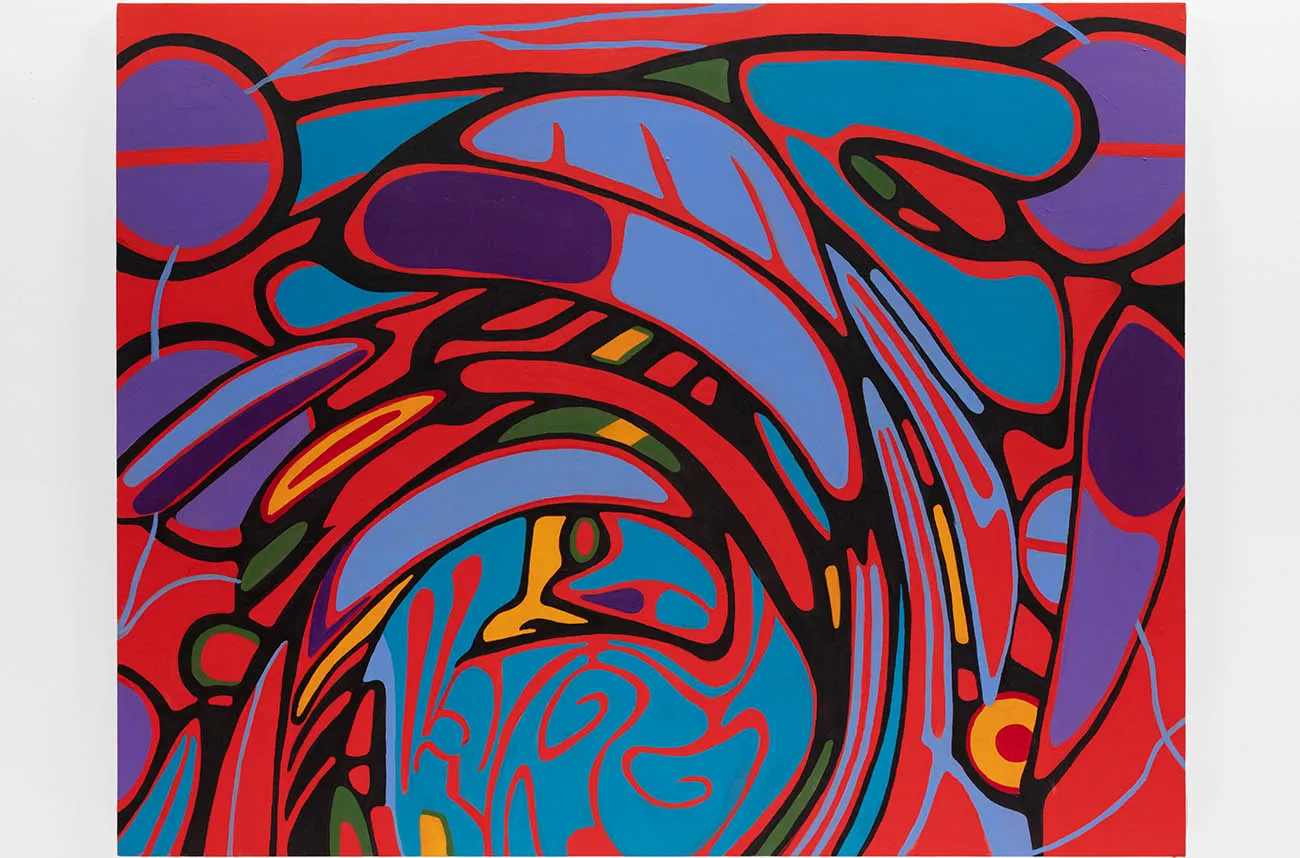The sky loves to hear me sing: Woodland Art in Transmotion
The sky loves to hear me sing: Woodland Art in Transmotion highlights the dynamic, migratory, and sovereign nature of Woodland Native art across time. Drawing on Anishinaabe literary theorist Gerald Vizenor's concept of "transmotion," or the sovereign assertion of movement through time, place, and visionary narrative, the exhibition explores the capacity of images, styles, belongings, and artistic careers to contradict essentialized notions of “place” and identity. In the work of artists such as Norval Morrisseau (1932-2007, Ojibwe); Andrea Carlson (Ojibwe); Alan Michelson (Mohawk); and Native Art Department International, a collaborative partnership between Toronto-based artists Maria Hupfield (Anishinaabe, member of the Wasauksing First Nation) and Jason Lujan (Chiricahua Apache and Mexican), medium and form unmoor themselves from entrenched categories and roam broad sites of aesthetic and historical inquiry. These artists explore and embody visual movement(s) throughout the international meeting places of the Eastern Woodlands, challenging border regimes and colonial prerogatives while asserting the right to artistic migration in its manifold manifestations.
Gerald Vizenor (Anishinaabe, enrolled citizen of the White Earth Nation)is Professor Emeritus of American Studies at the University of California, Berkeley. He is a citizen of the White Earth Nation in Minnesota, and has published more than forty books, novels, literary and cultural studies, and poetry. Native Provenance: The Betrayal of Cultural Creativity, a collection of essays, is his most recent publication. Vizenor has received many awards including the American Book Award for Griever: An American Monkey King in China, the Western Literature Association Distinguished Achievement Award, and the Mark Twain Award from the Society for the Study of Midwestern Literature.
Featured artists
Norval Morrisseau (1931-2007, Bingwi Neyaashi Anishinaabek, First Nation), is a painter and founder of the Woodland School of Art. A member of Professional Native Indian Artists Inc, which later became known as the Indian Group of Seven, he is considered to be the grandfather of contemporary Indigenous art in Canada. In 1984, his influence was recognized by the Art Gallery of Ontario, which organized the traveling retrospective: Norval Morrisseau and the Emergence of the Image Makers. Morrisseau was made a Member of the Order of Canada and a member of the Royal Canadian Academy of Arts. In 2008, the Canadian National Arts Centre, honored him with a posthumous Lifetime Achievement Award. In 2006, the National Gallery of Canada organized Norval Morrisseau: Shaman Artist, its first major solo exhibition of a First Nations artist.
Alan Michelson (b.1953, Mohawk) is a renowned artist, curator, writer, and Mohawk member of the Six Nations of the Grand River. For over three decades, he has been a leading practitioner of a socially engaged, critically aware, site-specific art grounded in local context and informed by the retrieval of repressed histories. His work was recently exhibited at the 14 th Gwangju Biennale, the Tate Modern, MoMA/PS1, and the Whitney Museum of American Art, and is currently on view at the Baltimore Art Museum, and the Thomas Cole National Historic Site.His diverse practice includes award-winning public art, and Mantle, his permanent, site-specific monument honoring Virginia’s Indian nations was dedicated at the capitol in Richmond in 2018. The Knowledge Keepers, his Huntington Avenue Entrance Commission at MFA Boston launches on November 14, 2024. His essays have appeared in Aperture, Frieze, and October, and his work has been featured in numerous publications, including the New York Times and Art in America. Michelson was co-founder and co-curator of the groundbreaking Indigenous New York series with the Vera List Center for Art and Politics at the New School, on whose board he currently serves.
Andrea Carlson (b. 1979, Ojibwe) is an artist based in northern Minnesota and Chicago. Carlson’s work includes multimedia artworks, works on paper, and public art projects, including a billboard project at the Whitney Museum of American Art in 2021. Recently, Carlson participated in the Toronto Biennial, completed a residency at the Joan Mitchell Center, and was selected as part of Prospect.6, an upcoming triennial organized by Prospect New Orleans. Carlson received a 2021 Chicago Artadia Award, a 2022 United States Artists Fellowship, and a 2024 Creative Capital Award. The artist’s writing has appeared in books such as Indigenous Futurisms (IAIA Museum of Contemporary Indian Arts, 2020) and Jaune Quick-to-See Smith: Memory Map (Whitney Museum of American Art, 2023), as well as in online publications such as e-flux Architecture. Carlson is a co-founder of the Center for Native Futures, an art space dedicated to the work of Native artists in Chicago.
Native Art Department International is a collaborative long-term project created and administered by Maria Hupfield (Canada) and Jason Lujan (USA). Working across platforms, NADI’s projects and exhibitions prioritize kinship, relationality, and non-competition in order to liberate artists, artworks and aesthetics from classifications ingrained in systems of power and interpretation. Their multi-disciplinary practice comprising performance, sculpture and video engages collaborative approaches to bypass essentialist readings of artworks and reject reductionist positions projected onto the work of Indigenous cultural producers. Their projects, as a result, circumvent easy categorization by comprising diverse forms such as curated exhibitions, video screenings, panel talks, collective art making, and an online presence, all sharing an undercurrent of positive progress and emancipation through cooperative alliances. Working across international contexts while consistently prioritizing being in relationship to place, they describe their work as “focusing on communications platforms and art-world systems of support while at the same time functioning as emancipation from essentialism and identity-based artwork.”
This exhibition was organized by the List Gallery and curated by Visiting Assistant Professor of Art History and Environmental Studies Christopher Green. Funding for all events and an accompanying catalog was made possible by the William J. Cooper Foundation. All events are free and open to the public.




